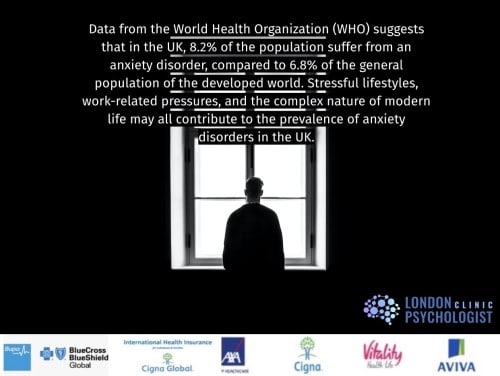Anxiety Disorders

posted 20th March 2023
Different Types of Anxiety
There are several different types of anxiety disorders, including generalized anxiety disorder, panic disorder, social anxiety disorder, obsessive-compulsive disorder, post-traumatic stress disorder, and phobias. Anxiety disorders can be caused by a variety of factors, including genetics, brain chemistry, personality, and life events. While it is not known exactly what causes anxiety disorders, research suggests that a combination of these factors may play a role. Additionally, some medical conditions, such as thyroid problems or heart disease, can trigger anxiety. The symptoms of an anxiety disorder can vary depending on the type of disorder and its severity. Common symptoms of anxiety disorders include excessive worry and fear, difficulty sleeping, restlessness, racing thoughts, difficulty concentrating, irritability, sweating, trembling, and shortness of breath. According to the Mental Health Foundation, anxiety disorders are the most common mental health problem in the UK, with over 8 million people affected. Anxiety disorders are more common in women than in men, and the prevalence is highest among young adults. In 2020, it was estimated that 8.4% of people in the UK were affected by an anxiety disorder. The exact causes of the high prevalence of anxiety disorders in the UK are not completely known. However, experts believe that the high prevalence is in part due to the stresses of modern life, such as the pressure of work and family life, as well as the increasing prevalence of mental health issues in general. Additionally, women may be more likely to report anxiety symptoms than men, due to gender-related cultural expectations and a greater willingness to seek help.
1. Generalized Anxiety Disorder (GAD): GAD is characterized by excessive and unrealistic worry and fear about everyday activities and situations. For example, someone with GAD may constantly worry about their job, finances, health, or other aspects of their life.
2. Panic Disorder: Panic disorder is characterized by sudden, intense episodes of fear and anxiety that can lead to physical symptoms such as heart palpitations, shortness of breath, and chest pain. For example, someone with panic disorder may experience a panic attack when faced with a situation that they perceive as dangerous or stressful.
3. Social Anxiety Disorder: Social anxiety disorder is characterized by an intense fear of being judged or evaluated by others in social or performance settings. For example, someone with social anxiety disorder may experience extreme anxiety in social situations, such as speaking in public or attending a party.
4. Obsessive-Compulsive Disorder (OCD): OCD is characterized by intrusive, unwanted thoughts or images (obsessions) and repetitive behaviors or mental acts (compulsions) that a person feels driven to perform. For example, someone with OCD may have an obsession with germs and resort to compulsive handwashing to reduce their anxiety.
5. Post-Traumatic Stress Disorder (PTSD): PTSD is a disorder that occurs after experiencing a traumatic event, such as a natural disaster, a serious accident, or a violent attack. For example, someone with PTSD may experience flashbacks, nightmares, and extreme anxiety when reminded of the traumatic event.
6. Phobias: Phobias are irrational fears of a specific object or situation. For example, someone with a phobia of heights may experience extreme fear and anxiety when exposed to heights or heights-related activities. An example of a specific phobia is someone struggling with death anxiety. They may feel overwhelmed by the idea of leaving their loved ones behind and fear the unknown of what lies beyond death. They may also be anxious about the pain and suffering associated with their impending death.
Anxiety disorder treatment typically involves a combination of psychotherapy, medication, and lifestyle changes. Psychotherapy and counseling can help a person understand and manage their symptoms, while medications can be used to reduce the intensity and frequency of anxiety. Lifestyle changes, such as reducing stress and getting more exercise, can also be beneficial for managing anxiety. The severity of symptoms can vary from person to person and from disorder to disorder. In general, symptoms of anxiety disorders can range from mild to severe and may include difficulty concentrating, restlessness, racing thoughts, difficulty sleeping, sweating, trembling, shortness of breath, and excessive worry and fear. It is important to seek professional help if you are experiencing any of these symptoms.



